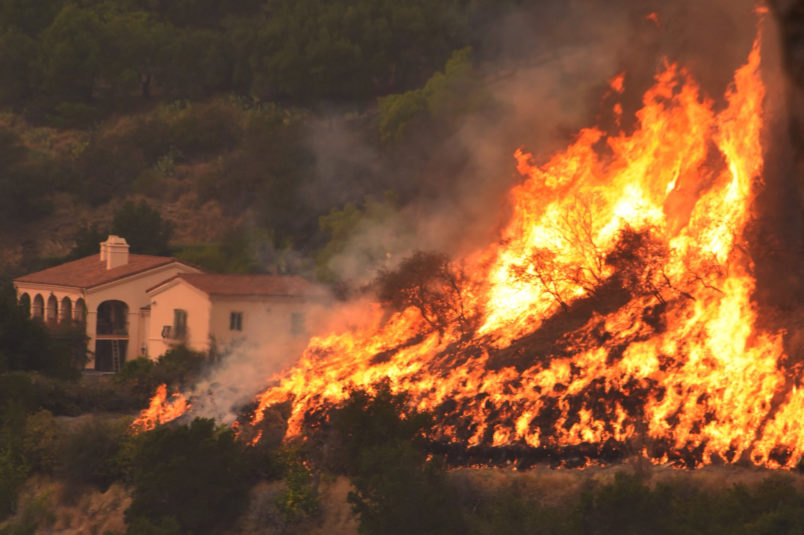
5 Ways to Prepare, Pre-empt, and Protect in the Event of Fire
The recent string of destructive California fires derives from a perfect storm of long-standing conditions now culminating in crisis. These contributing factors include decades of forest mismanagement, more people in fire-prone areas, and climate change. The rebuilding of homes damaged and destroyed in the Woolsey fire will also cause a shortage of contractors and will drive higher construction costs in the next 6-12 months. We are not trying to debate the reasons why the fires are happening. We intend, instead, to provide tips for how to be better prepared for the future, pre-empting cataclysm and protecting our way of life.
Fire Safety Precautions for the House
Secure the home and the area 0-5’ from the furthest attached exterior point of the home. Start with the house itself, then move into the landscaping section of the immediately surrounding area.
- Clean roofs and gutters of dead leaves, debris and pine needles that could catch embers.
- Replace or repair any loose or missing shingles or roof tiles to prevent ember penetration.
- Reduce embers that could pass through vents in the eaves by installing 1/8-inch metal mesh screening.
- Clean debris from exterior attic vents and install 1/8-inch metal mesh screening to reduce embers.
- Repair or replace damaged or loose window screens and any broken windows. Screen or box-in areas below patios and decks with wire mesh to prevent debris and combustible materials from accumulating.
- Move anything that can burn from wall exteriors – mulch, flammable plants, leaves and needles, firewood piles. Remove anything stored underneath decks or porches.
- There are also high-tech solutions homeowners can adopt, such as installing sprinklers on their roofs to keep things damp when a fire first erupts.
Fire Safety Precautions for the Area around the House
Secure the area 5-30’ from the furthest exterior point of the home. Employ careful landscaping and create hardscaping breaks that can alleviate the spread and decrease the intensity of fires.
- Clear vegetation from under large stationary propane tanks.
- Create fuel breaks with driveways, walkways/paths, patios, and decks.
- Keep lawns and native grasses mowed to a height of four inches.
- Remove ladder fuels (vegetation under trees) so that a surface fire cannot reach the crowns. Prune trees up to six to ten feet from the ground; for shorter trees do not exceed 1/3 of the overall tree height.
- Space trees to have a minimum of eighteen feet between crowns with the distance increasing with the percentage of slope.
- Tree placement should be planned to ensure the mature canopy is no closer than ten feet to the edge of the structure.
- Trees and shrubs in this zone should be limited to small clusters of a few each to break up the continuity of the vegetation across the landscape.
Fire Safety Precautions in the Neighborhood
Secure the area 30-100 feet, out to 200 feet. In designing landscaping in common spaces, strive to interrupt the fire’s path and keep flames smaller and on the ground should flames erupt.
- Dispose of heavy accumulations of ground litter/debris.
- Remove dead plants and tree material.
- Remove small conifers growing between mature trees.
- Remove vegetation adjacent to storage sheds or other outbuildings within this area.
- Trees 30 to 60 feet from the home should have at least 12 feet between canopy tops.
- Trees 60 to 100 feet from the home should have at least 6 feet between the canopy tops.
Be Prepared to Evacuate
- Sign up for the community’s warning system.
- Know your community evacuation plan and find several ways to leave the area. Drive the evacuation routes. Have a plan for pets and livestock.
- Gather emergency supplies, including N95 respirator masks. Keep in mind each person’s specific needs, including an updated asthma action plan and medication.
- Keep important documents in a fireproof, safe place. Create password-protected digital copies.
Review your Insurance
- Review insurance coverage to make sure it’s enough to protect your property. Does the policy cover damage for a fixed amount set when you bought the house? Update it annually based on the replacement costs or consider a policy that has automatic coverage increases.
- What is “replacement cost” coverage in your policy? Sometimes it covers the cost of a damaged home with a similar home, but some insurance companies can limit that at 20% over or of the face value of the policy.
- Insurance claims processing can be especially challenging in hard-hit areas. To offset the infusion of funds, the market might see a dramatic uptick in prices. Be sure to include language in your homeowner’s insurance that specifically indemnifies you, making you whole. Ask your insurer for coverage that will “bring your damaged home up to new building codes” in the event of fire damage.
- Consider purchasing an extended replacement cost endorsement, which covers extras above the policy limit in the event of any unexpected cost increases, and additional coverage for code-upgrade insurance to cover other things a basic policy might not protect.
- Be prepared to file an insurance claim before the fire. Take your smartphone and walk around your home filming a video of your belongings while your home is in good order. This can provide helpful evidence if an insurer disputes, say, that you owned a state-of-the-art home-theater, etc.
- Keep these images on a computer drive or iCloud so they’re accessible from virtually anywhere.

